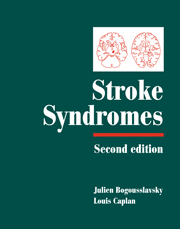Book contents
- Frontmatter
- Contents
- List of contributors
- Preface
- PART I CLINICAL MANIFESTATIONS
- 1 Stroke onset and courses
- 2 Clinical types of transient ischemic attacks
- 3 Hemiparesis and other types of motor weakness
- 4 Sensory abnormality
- 5 Cerebellar ataxia
- 6 Headache: stroke symptoms and signs
- 7 Eye movement abnormalities
- 8 Cerebral visual dysfunction
- 9 Visual symptoms (eye)
- 10 Vestibular syndromes and vertigo
- 11 Auditory disorders in stroke
- 12 Abnormal movements
- 13 Seizures and stroke
- 14 Disturbances of consciousness and sleep–wake functions
- 15 Aphasia and stroke
- 16 Agitation and delirium
- 17 Frontal lobe stroke syndromes
- 18 Memory loss
- 19 Neurobehavioural aspects of deep hemisphere stroke
- 20 Right hemisphere syndromes
- 21 Poststroke dementia
- 22 Disorders of mood behaviour
- 23 Agnosias, apraxias and callosal disconnection syndromes
- 24 Muscle, peripheral nerve and autonomic changes
- 25 Dysarthria
- 26 Dysphagia and aspiration syndromes
- 27 Respiratory dysfunction
- 28 Clinical aspects and correlates of stroke recovery
- PART II VASCULAR TOPOGRAPHIC SYNDROMES
- Index
- Plate section
1 - Stroke onset and courses
from PART I - CLINICAL MANIFESTATIONS
Published online by Cambridge University Press: 17 May 2010
- Frontmatter
- Contents
- List of contributors
- Preface
- PART I CLINICAL MANIFESTATIONS
- 1 Stroke onset and courses
- 2 Clinical types of transient ischemic attacks
- 3 Hemiparesis and other types of motor weakness
- 4 Sensory abnormality
- 5 Cerebellar ataxia
- 6 Headache: stroke symptoms and signs
- 7 Eye movement abnormalities
- 8 Cerebral visual dysfunction
- 9 Visual symptoms (eye)
- 10 Vestibular syndromes and vertigo
- 11 Auditory disorders in stroke
- 12 Abnormal movements
- 13 Seizures and stroke
- 14 Disturbances of consciousness and sleep–wake functions
- 15 Aphasia and stroke
- 16 Agitation and delirium
- 17 Frontal lobe stroke syndromes
- 18 Memory loss
- 19 Neurobehavioural aspects of deep hemisphere stroke
- 20 Right hemisphere syndromes
- 21 Poststroke dementia
- 22 Disorders of mood behaviour
- 23 Agnosias, apraxias and callosal disconnection syndromes
- 24 Muscle, peripheral nerve and autonomic changes
- 25 Dysarthria
- 26 Dysphagia and aspiration syndromes
- 27 Respiratory dysfunction
- 28 Clinical aspects and correlates of stroke recovery
- PART II VASCULAR TOPOGRAPHIC SYNDROMES
- Index
- Plate section
Summary
Introduction
The onset and early natural course of stroke gives critical information about the stroke mechanism (Caplan, 1993). For example, the deficit which is maximal at onset and not associated with headache is most compatible with an embolic mechanism, while a stuttering onset with improvement followed by worsening in the deficit would be against cerebral hemorrhage, but most compatible with a thrombotic process. The gradual development of a progressive focal deficit, accompanied by gradually developing symptoms of increased intracranial pressure, may suggest cerebral hemorrhage (Caplan, 1993).
Despite the clinical importance of understanding the time course, there have not been many stroke databanks referring to it. In the Harvard Cooperative Stroke Registry, speed of onset was classified into four subtypes, and recorded for each type of stroke (Mohr et al., 1978). A similar classification of speed of onset has been used in the Lausanne Stroke Registry (Bogousslavsky et al., 1988). Table 1.1 shows the speed of onset for each subtype of stroke reported in these two registries. One may see the similarity of speed of onset in each subtype of stroke between the data from the two stroke registries, despite the different criteria to identify stroke subtype.
Onset and time course in early phase of stroke
Ischemic stroke
Anterior circulation damage
Jones and Millikan (1976) reported the temporal profile of 179 patients with acute carotid ischemic stroke. In their study, 39% of patients had sudden onset and no change in the neurological deficit during the first 7 days after the onset, while 35% of the patients showed improvement, 22% showed progression or remission and relapse of deficit, and 4% experienced later worsening of neurological deficit after a stable profile of at least 2 days.
- Type
- Chapter
- Information
- Stroke Syndromes , pp. 3 - 7Publisher: Cambridge University PressPrint publication year: 2001
- 1
- Cited by



